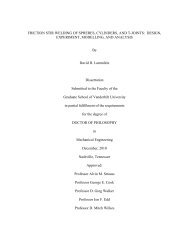manual
manual
manual
Create successful ePaper yourself
Turn your PDF publications into a flip-book with our unique Google optimized e-Paper software.
Wound Observation Between Dressing Changes<br />
If you wish to observe the wound between dressing changes, simply cut the foam into two<br />
pieces prior to placing in the wound and place three strips of drape horizontally across the<br />
top of the foam dressing. To observe the wound, simply remove the middle strip, which<br />
should be placed directly over the break between the two pieces of foam, separate the foam<br />
and observe the wound. After inspection, realign the two pieces of foam, always ensure they<br />
are touching each other, and reseal with an additional strip of drape.<br />
Adjunct Dressing Recommendations:<br />
1. All adjunct dressings utilized with V.A.C. ® Therapy must be meshed or pie-crusted<br />
to allow for even distribution of negative pressure and effective exudate removal.<br />
2. Silver-impregnated dressings can be used in conjunction with the V.A.C. ®<br />
Vers-foam and V.A.C. ® GranuFoam ® . V.A.C. ® Vers-foam is pre-moistened with<br />
sterile water; therefore, no special considerations should be required to ensure bene<br />
fits of the silver ion dressing. Special considerations should still be taken to evenly fen<br />
estrate across a potentially occlusive silver dressing. This will allow for proper exudate<br />
removal and even distribution of negative pressure.<br />
3. Small areas of the wound can be covered with absorptive dressings. The majority of<br />
the wound surface must be in contact with the V.A.C. ® foam dressing. The exudate<br />
may pool, forming a viscous or gel-like consistency and block negative pressure<br />
distribution to the underlying tissues. Maceration or other tissue damage may occur.<br />
4. In the presence of sutures or staples: Superficial or retention sutures should be<br />
covered with a single layer of non-adherent prior to foam placement. This protects<br />
the suture from becoming lodged into the open-cell foam during the delivery of<br />
negative pressure.<br />
16

















